Input interpretation

rubidium (chemical element) | helium (chemical element) | potassium (chemical element)
Periodic table location
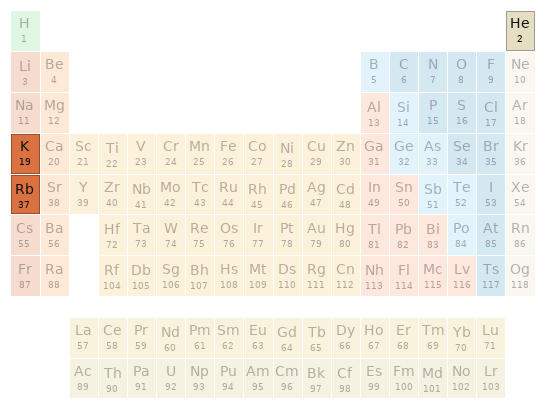
Periodic table location
Images
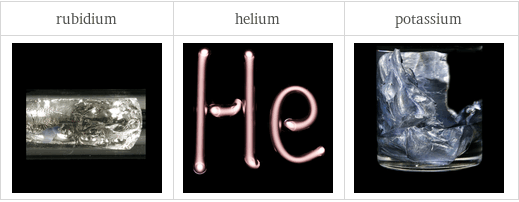
Images
Basic elemental properties
![| rubidium | helium | potassium atomic symbol | Rb | He | K atomic number | 37 | 2 | 19 short electronic configuration | [Kr]5s^1 | 1s^2 | [Ar]4s^1 Aufbau diagram | 5s | 1s | 4s block | s | s | s group | 1 | 18 | 1 period | 5 | 1 | 4 atomic mass | 85.4678 u | 4.002602 u | 39.0983 u half-life | (stable) | (stable) | (stable)](../image_source/dc48d0bba6bba6dbe4e84a3f3604794f.png)
| rubidium | helium | potassium atomic symbol | Rb | He | K atomic number | 37 | 2 | 19 short electronic configuration | [Kr]5s^1 | 1s^2 | [Ar]4s^1 Aufbau diagram | 5s | 1s | 4s block | s | s | s group | 1 | 18 | 1 period | 5 | 1 | 4 atomic mass | 85.4678 u | 4.002602 u | 39.0983 u half-life | (stable) | (stable) | (stable)
Thermodynamic properties
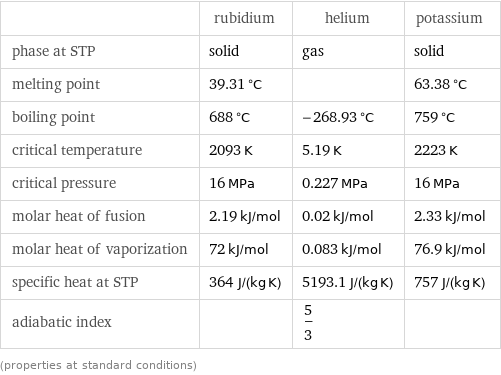
| rubidium | helium | potassium phase at STP | solid | gas | solid melting point | 39.31 °C | | 63.38 °C boiling point | 688 °C | -268.93 °C | 759 °C critical temperature | 2093 K | 5.19 K | 2223 K critical pressure | 16 MPa | 0.227 MPa | 16 MPa molar heat of fusion | 2.19 kJ/mol | 0.02 kJ/mol | 2.33 kJ/mol molar heat of vaporization | 72 kJ/mol | 0.083 kJ/mol | 76.9 kJ/mol specific heat at STP | 364 J/(kg K) | 5193.1 J/(kg K) | 757 J/(kg K) adiabatic index | | 5/3 | (properties at standard conditions)
Material properties
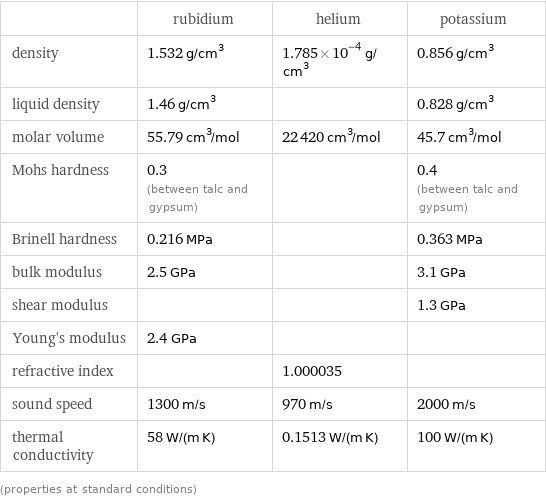
| rubidium | helium | potassium density | 1.532 g/cm^3 | 1.785×10^-4 g/cm^3 | 0.856 g/cm^3 liquid density | 1.46 g/cm^3 | | 0.828 g/cm^3 molar volume | 55.79 cm^3/mol | 22420 cm^3/mol | 45.7 cm^3/mol Mohs hardness | 0.3 (between talc and gypsum) | | 0.4 (between talc and gypsum) Brinell hardness | 0.216 MPa | | 0.363 MPa bulk modulus | 2.5 GPa | | 3.1 GPa shear modulus | | | 1.3 GPa Young's modulus | 2.4 GPa | | refractive index | | 1.000035 | sound speed | 1300 m/s | 970 m/s | 2000 m/s thermal conductivity | 58 W/(m K) | 0.1513 W/(m K) | 100 W/(m K) (properties at standard conditions)
Electromagnetic properties
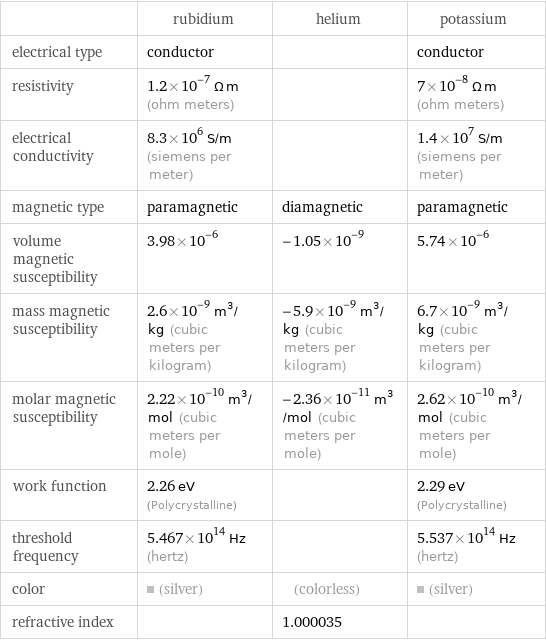
| rubidium | helium | potassium electrical type | conductor | | conductor resistivity | 1.2×10^-7 Ω m (ohm meters) | | 7×10^-8 Ω m (ohm meters) electrical conductivity | 8.3×10^6 S/m (siemens per meter) | | 1.4×10^7 S/m (siemens per meter) magnetic type | paramagnetic | diamagnetic | paramagnetic volume magnetic susceptibility | 3.98×10^-6 | -1.05×10^-9 | 5.74×10^-6 mass magnetic susceptibility | 2.6×10^-9 m^3/kg (cubic meters per kilogram) | -5.9×10^-9 m^3/kg (cubic meters per kilogram) | 6.7×10^-9 m^3/kg (cubic meters per kilogram) molar magnetic susceptibility | 2.22×10^-10 m^3/mol (cubic meters per mole) | -2.36×10^-11 m^3/mol (cubic meters per mole) | 2.62×10^-10 m^3/mol (cubic meters per mole) work function | 2.26 eV (Polycrystalline) | | 2.29 eV (Polycrystalline) threshold frequency | 5.467×10^14 Hz (hertz) | | 5.537×10^14 Hz (hertz) color | (silver) | (colorless) | (silver) refractive index | | 1.000035 |
Reactivity
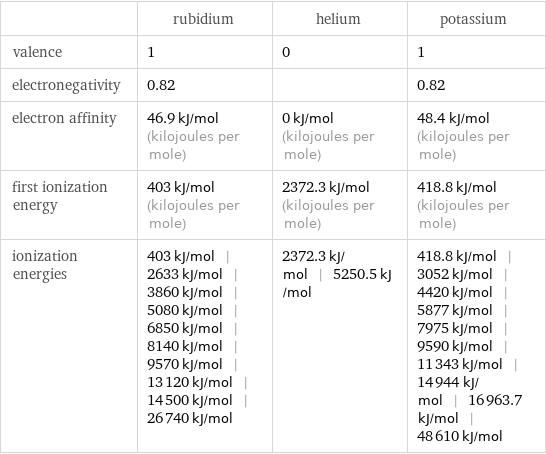
| rubidium | helium | potassium valence | 1 | 0 | 1 electronegativity | 0.82 | | 0.82 electron affinity | 46.9 kJ/mol (kilojoules per mole) | 0 kJ/mol (kilojoules per mole) | 48.4 kJ/mol (kilojoules per mole) first ionization energy | 403 kJ/mol (kilojoules per mole) | 2372.3 kJ/mol (kilojoules per mole) | 418.8 kJ/mol (kilojoules per mole) ionization energies | 403 kJ/mol | 2633 kJ/mol | 3860 kJ/mol | 5080 kJ/mol | 6850 kJ/mol | 8140 kJ/mol | 9570 kJ/mol | 13120 kJ/mol | 14500 kJ/mol | 26740 kJ/mol | 2372.3 kJ/mol | 5250.5 kJ/mol | 418.8 kJ/mol | 3052 kJ/mol | 4420 kJ/mol | 5877 kJ/mol | 7975 kJ/mol | 9590 kJ/mol | 11343 kJ/mol | 14944 kJ/mol | 16963.7 kJ/mol | 48610 kJ/mol
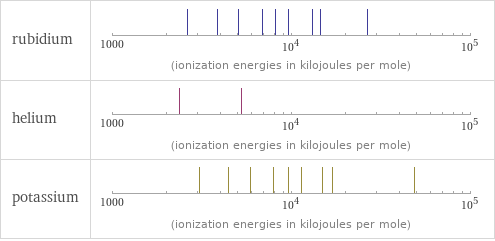
Reactivity
Atomic properties

| rubidium | helium | potassium term symbol | ^2S_(1/2) | ^1S_0 | ^2S_(1/2) atomic radius | 235 pm | 31 pm | 220 pm covalent radius | 220 pm | 28 pm | 203 pm van der Waals radius | | 140 pm | 275 pm (electronic ground state properties)
Abundances
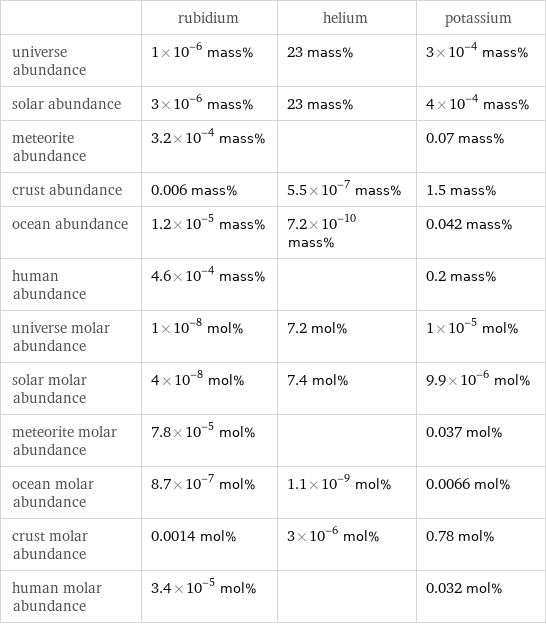
| rubidium | helium | potassium universe abundance | 1×10^-6 mass% | 23 mass% | 3×10^-4 mass% solar abundance | 3×10^-6 mass% | 23 mass% | 4×10^-4 mass% meteorite abundance | 3.2×10^-4 mass% | | 0.07 mass% crust abundance | 0.006 mass% | 5.5×10^-7 mass% | 1.5 mass% ocean abundance | 1.2×10^-5 mass% | 7.2×10^-10 mass% | 0.042 mass% human abundance | 4.6×10^-4 mass% | | 0.2 mass% universe molar abundance | 1×10^-8 mol% | 7.2 mol% | 1×10^-5 mol% solar molar abundance | 4×10^-8 mol% | 7.4 mol% | 9.9×10^-6 mol% meteorite molar abundance | 7.8×10^-5 mol% | | 0.037 mol% ocean molar abundance | 8.7×10^-7 mol% | 1.1×10^-9 mol% | 0.0066 mol% crust molar abundance | 0.0014 mol% | 3×10^-6 mol% | 0.78 mol% human molar abundance | 3.4×10^-5 mol% | | 0.032 mol%